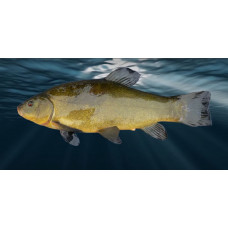The tench (Tinca tinca) is a freshwater fish of the carp family. The only species of the genus. The body is thick, scales are small dense. The mouth is small terminal. It inhabits the waters of Europe and Siberia. Predominantly lake and pond fish. Usually adheres to quiet, overgrown with soft vegetation, muddy bays of rivers, streams, channels with a weak current. Length up to 60 cm, weight up to 7.5 kg. Matures at the age of 3-4 years. Spawning is portioned, in June-July at a temperature of 19-20°C. Fecundity is 300-400 million eggs. It feeds on insect larvae, worms, mollusks, algae. Fishery value is low. Object of pond fish breeding.
Considered an invasive species in some regions. It inhabits mainly shallow lakes and ponds with dense aquatic vegetation and muddy bottoms, as well as rivers with slow currents. Reaches a length of up to 70 cm and a weight of up to 7.5 kg. Fish have sexual dimorphism, manifested in the difference in the length of the pectoral and pelvic fins, which are longer in the male. Fish reach sexual maturity at the age of 2-6 years, in Poland usually at the age of 3-4 years. The species is highly fecund: females are capable of producing up to one million small eggs, but usually around 360,000-400,000. It is a popular species for breeding.
The short, tall and thick body of the tench is covered with fine, tightly fitting scales and a thick layer of mucus. There are 90-120 scales in the lateral line. Body coloration depends on habitat conditions: from greenish-silver (in clear water with sandy ground) to dark brown with bronze tint (in water bodies with muddy ground). Dorsal and anal fins are relatively short. The dorsal fin has 4 unbranched and 8-9 branched rays, the anal fin has 3 unbranched and 8-9 branched rays. Caudal fin without a notch. In sexually mature males, the second ray of pelvic fins thickened. In the corners of the mouth is located one short (about 2 mm) antennae. The pharyngeal teeth are single-rowed, their formula: 4-5, 5-4. Gill stamens are 14-20. Eyes are small, red-orange in color. In the tench secondary sexual characteristics are expressed quite clearly: males have larger pelvic fins and their second rays are thicker. Compared to the crucian carp has a thicker body, truncated caudal fin, 2 times fewer rays in the dorsal fin and 3 times more scales in the lateral line. By means of artificial selection, an ornamental form is bred - golden tench. It is distinguished by its intensely golden color and dark eyes.
Tench prefers to stay in quiet, overgrown with soft underwater vegetation river bays, estuaries, channels with a weak current. It feels well in lakes, large ponds, overgrown along the banks of reeds, reeds and sedges. Usually leads a solitary, sedentary lifestyle. It stays near the bottom, among thickets, avoiding bright light. Undemanding to the concentration of oxygen in the water, which allows him to live where many other species of fish can not survive. It feeds on bottom invertebrates (insect larvae, worms, mollusks), extracting them from the silt at a depth of 7-9 cm. In addition to animal organisms, adult fish eat aquatic plants and detritus, which can make up to 60% of their diet. The mature ling becomes sexually mature at the age of 3-4 years. The tench is a heat-loving fish, so it starts spawning in June - July (in Eastern Siberia in late July - early August) at water temperature of 18-20 °C. Fecundity is high - 300-400 thousand eggs. It spawns in macrophyte thickets. Eggs are small (size 1.0-1.2 mm), laid on plant stems. Incubation period is very short - several days.
In Europe, this species is a rather common representative of river and lake fauna. Some scientists believe that the species appeared in the Miocene. During the Pleistocene glaciations, its distribution range also extended to Central Europe. After the retreat of the ice sheet, the fish moved even further north. The tench is found in Eurasia, also in the USA and in many other regions of the world, including North and South Africa, Australia, New Zealand and Tasmania, India, North America and Chile, also elsewhere. In natural water bodies, commercial importance is low.
Tench
Tags: tench



